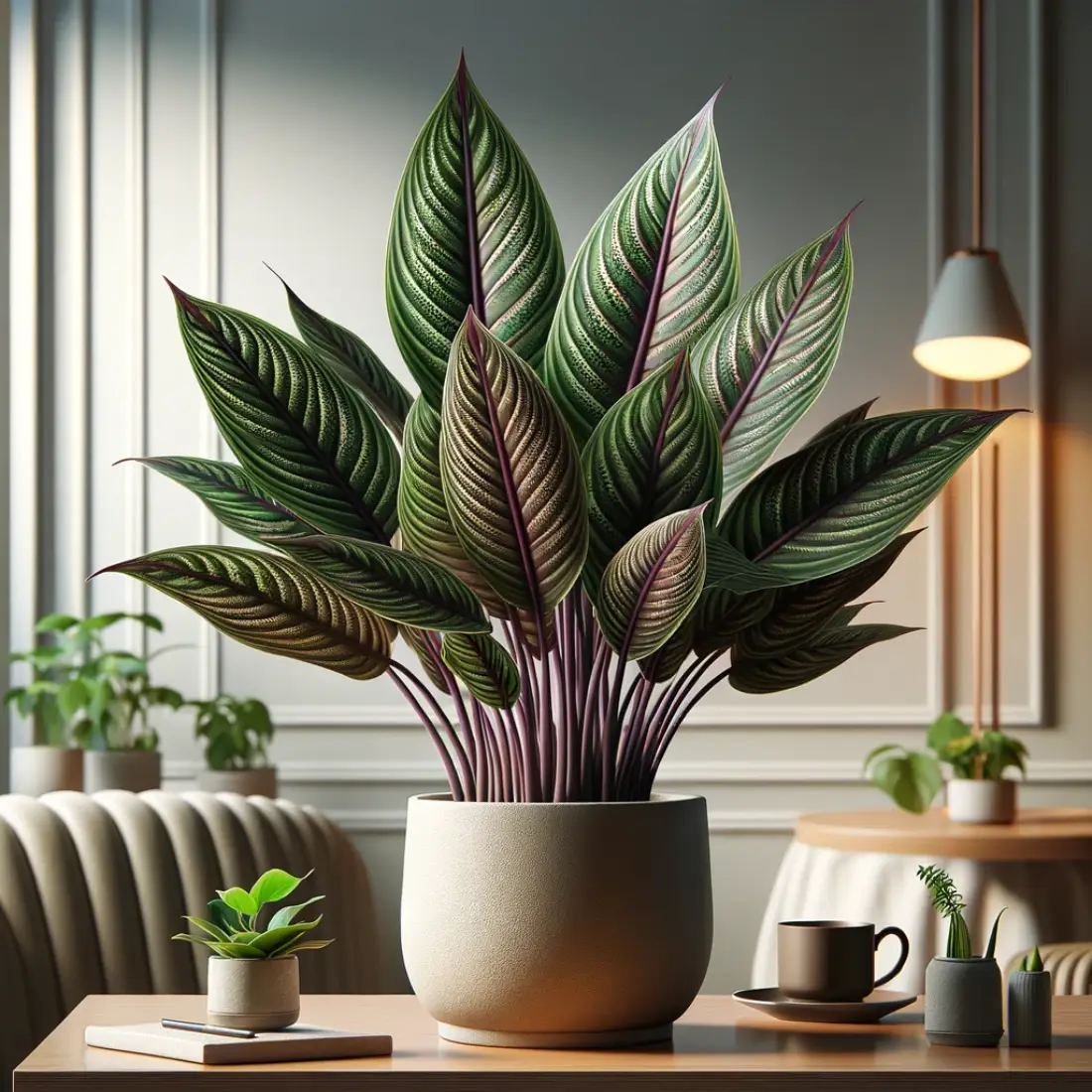Chinese Evergreen, scientifically known as Aglaonema, is a popular indoor plant recognized for its striking foliage and easy maintenance. Originating from the tropical and subtropical regions of Asia, this versatile plant has been a favorite among indoor gardeners and plant enthusiasts due to its adaptability to various light conditions and its attractive, variegated leaves that come in shades of green, silver, red, and pink.
Chinese Evergreen is part of the Araceae family, which includes other well-known houseplants such as the Peace Lily and Dieffenbachia.
Common Varieties and Their Characteristics
There are numerous varieties of Aglaonema, each with unique leaf patterns and colors. Some popular varieties include:
- Aglaonema ‘Silver Bay’: Known for its broad, silver-green leaves with dark green edges.
- Aglaonema ‘Red Siam Aurora’: Features vibrant red and pink accents along the leaf margins.
- Aglaonema ‘Maria’: Displays dark green leaves with silver streaks, ideal for low light conditions.
- Aglaonema ‘Emerald Beauty’: Boasts lush, green leaves with white speckles and veins.
Chinese Evergreen is not only aesthetically pleasing but also beneficial for indoor air quality. It is known for its ability to filter indoor pollutants such as benzene and formaldehyde, contributing to a healthier living environment.
Optimal Growing Conditions
To ensure your Chinese Evergreen (Aglaonema) thrives and remains healthy, it’s important to provide it with the optimal growing conditions. These include suitable temperature, light, humidity, and other environmental factors.
Ideal Climate and Temperature
- Temperature Range: Chinese Evergreens prefer a warm, stable environment. The ideal temperature range is between 60°F (15°C) and 75°F (24°C).
- Avoiding Temperature Extremes: These plants are sensitive to cold and should not be exposed to temperatures below 55°F (13°C). Sudden temperature changes and cold drafts should be avoided as they can cause stress to the plant, leading to leaf damage or loss.
- Seasonal Considerations: During winter, ensure the plant is kept away from windows and doors where cold air might seep in. In summer, protect it from excessive heat by placing it in a well-ventilated area.
Light Requirements
- Indirect Sunlight: Aglaonema thrives in bright, indirect light. Placing the plant near an east or north-facing window can provide adequate light without exposing it to direct sunlight, which can scorch the leaves.
- Low Light Tolerance: One of the remarkable features of Chinese Evergreen is its ability to adapt to low light conditions. It can survive in dimly lit areas, making it suitable for offices and rooms with limited natural light.
- Impact of Direct Sunlight: Direct sunlight should be avoided as it can cause the leaves to fade or develop brown spots. If the only available location receives direct sunlight, use sheer curtains to diffuse the light.
Humidity Needs
- Optimal Humidity Levels: Chinese Evergreen prefers moderate to high humidity levels, ideally between 50% and 60%. This mimics the tropical conditions of its native habitat.
- Maintaining Humidity: Use a humidifier to increase moisture in the air, especially during dry winter months. Place a tray filled with water and pebbles under the pot. As the water evaporates, it will increase the humidity around the plant. Group plants together to create a microenvironment with higher humidity.
Planting Chinese Evergreen
Proper planting is crucial for the healthy growth and development of Chinese Evergreen (Aglaonema). This includes selecting the right pot and soil, as well as following the correct planting steps.
Pot Selection:
- Size: Choose a pot that is proportionate to the size of the plant. A pot that is 1-2 inches larger in diameter than the plant’s root ball is ideal. Overly large pots can lead to waterlogging and root rot.
- Material: Pots made from materials like terracotta or ceramic with drainage holes are preferable. These materials allow for better air circulation around the roots.
- Drainage: Ensure the pot has sufficient drainage holes at the bottom to prevent water accumulation, which can cause root rot.
Soil Mix:
Well-Draining Soil: Chinese Evergreen requires well-draining soil to avoid waterlogged conditions. A mix that retains some moisture but drains excess water efficiently is ideal.
Recommended Mix: A good soil mix for Aglaonema can be made by combining equal parts of:
- Peat moss or coco coir (for moisture retention)
- Perlite or coarse sand (for drainage)
- Standard potting soil (for nutrients)
Additives: You can also add a small amount of charcoal to improve soil aeration and prevent odors.
Planting Steps
Preparing the Pot and Soil:
- Fill the bottom of the pot with a layer of pebbles or broken pottery pieces to enhance drainage.
- Add the prepared soil mix, filling the pot to about one-third of its height.
Preparing the Plant:
- Gently remove the Chinese Evergreen from its current pot. If the plant is root-bound, loosen the roots carefully with your fingers.
- Inspect the roots for any signs of rot or damage and trim if necessary.
Planting the Aglaonema:
- Place the plant in the center of the new pot. Ensure it is positioned at the same depth it was growing in the previous pot.
- Fill in around the roots with the remaining soil mix, pressing it down gently to eliminate air pockets.
- Leave a small gap (about 1 inch) between the soil surface and the pot’s rim to allow for watering.
Initial Watering and Placement:
- Water the plant thoroughly after planting to help settle the soil around the roots. Ensure excess water drains out from the bottom.
- Place the pot in a location that receives bright, indirect light, avoiding direct sunlight.
Watering Schedule for Chinese Evergreen (Aglaonema)
Proper watering is essential for maintaining the health and vitality of your Chinese Evergreen. It’s important to balance moisture levels to avoid both underwatering and overwatering.
Frequency of Watering
- Check Soil Moisture: The best way to determine when to water your Chinese Evergreen is by checking the soil moisture. Insert your finger about an inch into the soil. If it feels dry at that depth, it’s time to water.
- Typical Schedule: In general, water your Chinese Evergreen every 1-2 weeks. However, the exact frequency can vary based on factors such as light conditions, temperature, and humidity levels.
Seasonal Adjustments:
- Spring and Summer: During the growing season, the plant’s water requirements are higher. You may need to water more frequently, possibly once a week.
- Fall and Winter: In the dormant season, the plant’s growth slows down, and it requires less water. Watering once every 2-3 weeks may be sufficient.
Organic Fertilizing Routine for Chinese Evergreen (Aglaonema)
Using organic fertilizers for your Chinese Evergreen can enhance its growth and maintain soil health without the use of synthetic chemicals.
Types of Organic Fertilizers
Compost:
- Description: Decomposed organic matter that enriches the soil with nutrients and beneficial microorganisms.
- Application: Mix a layer of compost into the top inch of soil every 3-4 months.
Worm Castings:
- Description: Nutrient-rich excrement from earthworms that improve soil structure and fertility.
- Application: Incorporate a small handful of worm castings into the soil every 2-3 months.
Liquid Seaweed/Kelp Extract:
- Description: Extracts from seaweed provide trace minerals, growth hormones, and amino acids that promote plant health.
- Application: Dilute according to package instructions and apply as a foliar spray or soil drench every 4-6 weeks during the growing season.
Fish Emulsion:
- Description: A nutrient-rich liquid fertilizer made from decomposed fish, high in nitrogen.
- Application: Dilute as directed and water the plant with the solution every 4-6 weeks in the growing season.
Compost Tea:
- Description: A liquid produced by steeping compost in water, which is rich in nutrients and beneficial microbes.
- Application: Apply as a soil drench or foliar spray every 2-4 weeks during the growing season.
Fertilizing Schedule
Spring and Summer:
- Frequency: Fertilize every 4-6 weeks, as these are the active growing months for Chinese Evergreen.
- Method: Use a combination of compost, worm castings, and liquid fertilizers like seaweed extract or fish emulsion.
Fall and Winter:
- Frequency: Reduce fertilizing to once every 2-3 months, as the plant’s growth slows down during this period.
- Method: Apply compost and worm castings sparingly. Avoid liquid fertilizers unless the plant shows signs of nutrient deficiency.
Application Techniques
Top Dressing:
- Compost and Worm Castings: Apply a thin layer (about 1/4 inch) of compost or worm castings on the soil surface. Gently mix it into the top layer of soil without disturbing the roots.
Liquid Fertilizer:
- Dilution: Always dilute liquid fertilizers according to the instructions on the label to prevent root burn.
- Application: Water the plant thoroughly with the diluted solution, ensuring even distribution around the base.
Compost Tea:
- Preparation: Steep compost in water for 24-48 hours, then strain.
- Application: Use the tea to water the plant or as a foliar spray, ensuring the leaves and soil are well covered.
Pruning Guidelines
Removing Yellow or Damaged Leaves:
- Frequency: Prune yellow, brown, or damaged leaves as needed. This helps the plant conserve energy and maintain its appearance.
- Method: Use clean, sharp scissors or pruning shears. Cut the leaf stem close to the base of the plant.
Encouraging Bushier Growth:
- Selective Pruning: To encourage a fuller, bushier plant, prune leggy stems. Cut just above a leaf node (where a leaf attaches to the stem) to stimulate new growth.
- Timing: The best time for this type of pruning is during the growing season (spring and summer).
General Pruning Tips:
- Sterilization: Always sterilize your pruning tools before and after use to prevent the spread of disease. You can use rubbing alcohol or a diluted bleach solution.
- Pruning Amount: Avoid removing more than 20% of the plant at one time. Excessive pruning can stress the plant.
Seasonal Considerations
Spring and Summer:
- Active Growth: During these seasons, the plant is actively growing and may require more frequent pruning and maintenance.
- Repotting: Spring is the ideal time to repot your Chinese Evergreen if it has outgrown its pot. Choose a pot that is 1-2 inches larger in diameter.
Fall and Winter:
- Reduced Growth: Growth slows down during these seasons, so maintenance and pruning can be reduced.
- Watering and Feeding: Adjust watering and fertilizing schedules to reflect the plant’s reduced growth rate.
Step-by-Step Propagation Process
Propagation by Division:
- Tools Needed: Clean, sharp knife or shears, new pots, well-draining potting mix, and water.
- Water the Plant: Water the mother plant thoroughly a day before you plan to divide it. This ensures the roots are hydrated and makes them easier to separate.
Removing the Plant:
- Remove from Pot: Gently remove the Chinese Evergreen from its pot, being careful not to damage the roots.
- Loosen the Roots: Carefully loosen the soil around the roots and gently separate the root ball into smaller sections. Each section should have at least a few stems and a healthy root system.
Planting the Divisions:
- Prepare Pots: Fill new pots with well-draining potting mix, leaving enough space for the roots of each division.
- Plant the Divisions: Place each division in its new pot, fill in around the roots with soil, and press gently to remove air pockets.
- Water Thoroughly: Water the newly potted plants thoroughly and place them in a location with bright, indirect light.
Propagation by Stem Cuttings:
- Tools Needed: Clean, sharp knife or scissors, rooting hormone (optional), small pots, water, well-draining potting mix, and plastic bags or a humidity dome.
- Select a Stem: Choose a healthy stem with at least 4-6 inches in length and a few leaves.
Taking the Cuttings:
- Cut the Stem: Using a clean knife or scissors, cut the stem just below a node (where a leaf joins the stem). Remove the lower leaves, leaving at least two leaves at the top.
- Optional: Dip the cut end in rooting hormone to encourage faster root development.
Rooting the Cuttings:
In Water:
- Place the cutting in a glass or jar of water, ensuring the cut end is submerged but leaves are above the waterline.
- Place the container in bright, indirect light and change the water every few days to keep it fresh.
- Roots should start to develop within a few weeks. Once the roots are 1-2 inches long, transplant the cutting into soil.
In Soil:
- Fill a small pot with a well-draining potting mix and make a hole in the center.
- Insert the cutting into the hole, burying the cut end and node in the soil.
- Water the soil lightly and cover the pot with a plastic bag or use a humidity dome to maintain high humidity.
- Place the pot in bright, indirect light and keep the soil moist but not soggy. Roots should develop within a few weeks.
Post-Propagation Care:
- Light: Place the new plants in a location with bright, indirect light.
- Humidity: Maintain high humidity, especially for stem cuttings, until they are well-established.
- Watering: Keep the soil consistently moist but not waterlogged. Gradually reduce humidity once new growth appears.
By following these propagation methods, you can successfully grow new Chinese Evergreen plants, ensuring their healthy development and expanding your collection.
Troubleshooting Common Problems with Chinese Evergreen (Aglaonema)
Even with proper care, Chinese Evergreen can encounter a few common issues. Here’s a guide to identifying and addressing these problems effectively.
Yellowing Leaves
Symptoms: Leaves turning yellow, starting from the tips or edges.
Causes and Solutions:
- Overwatering: This is the most common cause. Ensure the soil is well-draining and allow the top inch to dry out between waterings. Reduce watering frequency and check for adequate drainage. If the plant is waterlogged, consider repotting it into fresh, dry soil.
- Underwatering: If the soil is too dry, the leaves can also turn yellow. Increase watering frequency, ensuring the soil remains moist but not soggy.
- Low Humidity: Insufficient humidity can cause yellowing leaves. Increase humidity around the plant using a humidifier or pebble tray with water.
- Nutrient Deficiency: Lack of essential nutrients, particularly nitrogen, can cause yellowing. Apply a balanced, organic fertilizer following the recommended schedule.
Brown Leaf Tips
Symptoms: Brown, crispy tips on the leaves.
Causes and Solutions:
- Low Humidity: Dry air can cause the leaf tips to turn brown. Increase humidity using a humidifier, misting the plant, or placing it on a pebble tray with water.
- Fluoride in Water: High fluoride levels in tap water can lead to brown tips. Use distilled or filtered water for watering your plant.
- Over-Fertilization: Excessive fertilizer can cause nutrient burn, leading to brown tips. Reduce the frequency and amount of fertilizer. Flush the soil with water to remove excess salts if over-fertilization is suspected.
Leggy Growth
Symptoms: Stems become long and spindly, with sparse foliage.
Causes and Solutions:
- Insufficient Light: Lack of adequate light can cause the plant to stretch towards the light source, resulting in leggy growth. Move the plant to a location with brighter, indirect light. Consider using grow lights if natural light is insufficient.
- Pruning: Regular pruning can help maintain a bushier appearance. Prune leggy stems by cutting just above a leaf node to encourage new growth.
Pests Infestation
Symptoms: Presence of tiny insects on the leaves and stems, webbing, or sticky residue.
Common Pests:
- Aphids: Small, green or black insects that cluster on new growth.
- Spider Mites: Tiny, spider-like pests that create fine webbing.
- Mealybugs: White, cotton-like insects often found in leaf joints.
Solutions:
- Natural Control: Wipe the leaves with a damp cloth to remove pests. Use a spray of water, insecticidal soap, or neem oil.
- Chemical Control: For severe infestations, consider using a systemic insecticide safe for indoor plants.
Root Rot
Symptoms: Mushy, black, or foul-smelling roots. Plant may wilt and the leaves turn yellow.
Causes and Solutions:
- Overwatering and Poor Drainage: These conditions promote fungal growth leading to root rot. Remove the plant from its pot, trim away affected roots, and repot in fresh, well-draining soil. Reduce watering and ensure proper drainage.
Drooping Leaves
Symptoms: Leaves appear wilted or droopy.
Causes and Solutions:
- Underwatering: Dry soil can cause the leaves to droop. Water the plant thoroughly and ensure consistent soil moisture.
- Overwatering: Too much water can also cause drooping leaves. Allow the soil to dry out between waterings and check for adequate drainage.
- Temperature Stress: Exposure to extreme temperatures can cause drooping. Maintain a stable temperature between 60°F and 75°F (15°C – 24°C), avoiding cold drafts and direct heat sources.
FAQs about Chinese Evergreen (Aglaonema)
How often should I water my Chinese Evergreen?
Water your Chinese Evergreen when the top inch of soil feels dry. Typically, this means watering every 1-2 weeks. Adjust the frequency based on the plant’s environment, watering more in summer and less in winter.
What kind of light does Chinese Evergreen need?
Chinese Evergreen thrives in bright, indirect light but can tolerate low light conditions. Avoid direct sunlight, which can scorch the leaves. North or east-facing windows are ideal.
How do I increase humidity for my Chinese Evergreen?
Increase humidity by using a humidifier, placing a pebble tray with water under the pot, or grouping your plant with other plants to create a more humid microenvironment. Misting the leaves occasionally can also help.
Why are the leaves of my Chinese Evergreen turning yellow?
Yellow leaves can be caused by overwatering, underwatering, low humidity, or nutrient deficiencies. Check the soil moisture, increase humidity if necessary, and ensure the plant receives balanced nutrition.
Can I propagate my Chinese Evergreen, and how?
Yes, you can propagate Chinese Evergreen by division or stem cuttings. Division involves separating the root ball into smaller sections, while stem cuttings involve rooting a cut stem in water or soil.
What is the best soil mix for Chinese Evergreen?
A well-draining soil mix is best for Chinese Evergreen. A mix of equal parts peat moss or coco coir, perlite or coarse sand, and standard potting soil works well.
How do I fertilize my Chinese Evergreen organically?
Use organic fertilizers such as compost, worm castings, liquid seaweed or kelp extract, fish emulsion, or compost tea. Apply these fertilizers every 4-6 weeks during the growing season (spring and summer) and reduce frequency during fall and winter.
What should I do if my Chinese Evergreen has brown leaf tips?
Brown leaf tips can be caused by low humidity, fluoride in water, or over-fertilization. Increase humidity, use distilled or filtered water, and reduce the amount of fertilizer. Trim the brown tips if needed.
How do I prevent and treat pest infestations on my Chinese Evergreen?
Regularly inspect your plant for pests such as aphids, spider mites, and mealybugs. Treat infestations with insecticidal soap, neem oil, or a mixture of water and mild dish soap. Maintain plant health through proper watering and humidity to prevent infestations.
Can Chinese Evergreen be grown outdoors?
Chinese Evergreen can be grown outdoors in tropical and subtropical regions where temperatures remain between 60°F and 75°F (15°C – 24°C). It should be placed in a shaded area to avoid direct sunlight. In temperate regions, it is best kept as an indoor plant.










